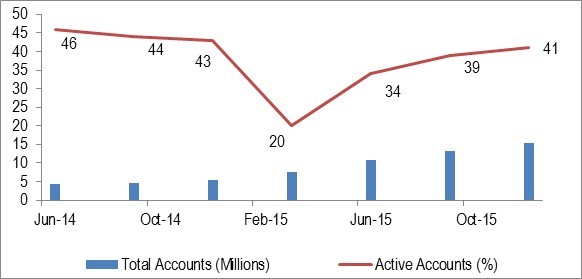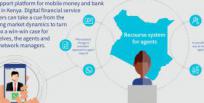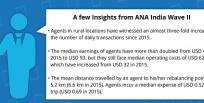In 2009, Pakistan spearheaded the over the counter (OTC) transaction revolution. But in the summer of 2017, the digital financial services (DFS) landscape may experience a watershed moment. In June 2016, the State Bank of Pakistan (SBP) announced that as of July 2017, all branchless banking players offering OTC transactions will be required to use biometric verification to send and receive funds. Currently, customers transacting using OTC only need a copy of their Computerised National Identity Card (CNIC) to send and receive payments. This regulation will have major implications for DFS providers in terms of their investments and system developments, as well as the need to educate customers and agents.
While leading players like Easypaisa, a mobile money service from Telenor Pakistan and Tameer Micro Finance Bank, have focused on converting their OTC customers to mobile account holders for the last two years, the proposed regulation puts pressure on them to migrate the majority of their 16.2 million OTC customers to the mobile account. This is not an easy task. Nevertheless, in this blog we focus on the strategies that have helped Easypaisa gain impressive numbers in mobile accounts, often overshadowed by OTC usage, and provide lessons to Pakistani DFS providers hoping to do the same.
OTC Growth Rate Is Actually Decreasing
The global annualised growth rate for the number of unregistered mobile money users who transacted using OTC was 22% in 2015, compared to 33% in 2014 and 102% in 2013. In South Asia, the 19% growth (year-on-year) of OTC in 2015 was surpassed by the 47% growth in registered mobile accounts. Easypaisa experienced 194% growth in mobile accounts versus 35% growth in OTC customers during this time period.In fact, the ratio of mobile account to OTC transactions has been increasing every quarter since 2014 for Easypaisa, as demonstrated by Table 1, reaching 77% in Q4 2015. This decrease in the OTC growth rate is also reflected in the country at large — mobile accounts grew by 183% between Q4 2014 and Q4 2015. By December 2015, Easypaisa had 9.8 million registered mobile accounts—64% of the total mobile accounts in Pakistan.
Part of this growth is due to the nation’s successful GSM biometric verification drive, where all the telecoms together successfully authenticated 68.7 million SIMs within 90 days in 2015. Easypaisa leveraged this verification drive by enabling its biometrically verified GSM customers to also simultaneously open mobile accounts, thus increasing their registration rate.
Additionally, the decrease in the OTC growth rate may be attributed to an increase in number of DFS players in the market, who rather than investing in new agents, utilized the country’s existing agents and offer similar OTC products—such as Person-to-Person (P2P) transfers and utility bill payments—on the same channel. As a result, this has granted agents a much greater influence over customers on which provider they should transact with. This power dynamic has put a lot of pressure on providers to offer competitive commissions—known as the infamous commission’s war—to their agents in order to have them specifically sell their services and lure new customers to their network.
Are Mobile Accounts Being Used?
Mobile account usage is a more useful indicator of the successful conversion of OTC customers to mobile accounts. Easypaisa has aggressively pushed new products and offered pricing incentives, among other approaches in an effort to increase usage of mobile accounts. For instance, Easypaisa dropped its P2P fees for mobile account holders in September 2014. Following this change, the number of P2P transactions increased from 15,000 that month to a peak of 783,000 P2P transactions in May 2016. As demonstrated in Figure 1, Pakistan witnessed a remarkable growth in both registered and active mobile accounts in 2015, whilst concurrently offering OTC transactions. As of December 2015, Easypaisa had 26% of Pakistan’s total active accounts and expects this percentage to increase.
Figure 1. Mobile Money Accounts versus Active Accounts (Pakistan)

Source: State Bank of Pakistan, Branchless Banking Newsletters
Mobile Account Strategies: What’s Worked
One of the driving factors for Easypaisa achieving mobile account growth was the team’s commitment to this goal. Indeed, both Easypaisa and Jazzcash—Easypaisa’s competitor — committed to working together to end the OTC commission war that was decreasing both providers’ profit margins. They took this bold action to focus instead on mobile accounts, as they understood that this is where the lion’s share of opportunities in DFS lies.
Some of the successful strategies taken by Easypaisa are as follows:
- Pricing. With the prevalence of OTC transactions, Easypaisa recognised that a pricing incentive could lure customers to mobile accounts. Easypaisa then waived all cash deposit, cash withdrawal, and P2P transfer fees. While this strategy does not result in profits, it enables registered customers to get accustomed to their mobile account, while making them more likely to sign up and employ other use cases on the wallet.
- Offer compelling use cases to your target customers. First and foremost, Easypaisa had to understand their customers’ financial journey, recognising that not all segments have the same financial needs and patterns. Easypaisa conducted market research to understand customers’ needs, preferences, desires, aspirations, as well as attitudes to financial services. With this research, Easypaisa has come up with three unique customer segments and have started rolling out a diverse product suite targeted to them. These use cases aim to solve real financial pain points, and also influence customers of the value of storing money on their mobile account. These products vary from retail payments, online payments, lending, saving, and insurance products, to ATM/debit cards.
- ATL and BTL marketing campaigns. Easypaisa’s OTC marketing campaigns proved effective as ‘Easypaisa kara lo’ [‘conduct an Easypaisa’] became a euphemism for money transfers. In 2015, Easypaisa changed their strategy and started focusing on educating customers — particularly middle-income customers as they see this segment as early adopters — on the value of a mobile account, beyond money transfers to include bill and merchant payments, as demonstrated by their TV advertisements.
- An Easypaisa account is actually SIM agnostic (telco operator agnostic). A customer can have a SIM card from any service provider in Pakistan and still utilise Easypaisa’s mobile account services. This move was especially important as 60% of OTC customers do not carry Telenor SIMs, and in this approach, Easypaisa is the first DFS provider to offer their services to any telecom customer.
- The introduction of the Easypaisa Mobile App. The rapid adoption of smartphones in Pakistan — currently at 11% ownership with an ambitious projection of 40 million by the end of the year– convinced the Easypaisa team to start offering newer, more user friendly channel in addition to USSD. Easypaisa’s team developed a faster and intuitive smart phone application where users can register their mobile account. Easypaisa understands that while smartphone penetration is increasing, there is a large customer segment that relies on feature phones that they will need to target and address according to their needs.
- Interoperability with the financial ecosystem. All Pakistani banks are connected to the 1-Link switch, and in addition to facilitating ATM transactions, the Inter-Bank Funds Transfer (IBFT) services offered by the 1-Link service, allows Easypaisa mobile account users to move funds from any bank to their mobile account and vice versa. This interoperability also facilitates fund transfers between different DFS mobile accounts today.
What Does the Future Hold?
Easypaisa has always maintained that rolling out OTC transactions first was the right thing to do and they would undoubtedly do it all over again. Usage matters, and as discussed in our previous blog, OTC does not prevent product evolution and usage of mobile accounts, but can enable customers to build familiarity with DFS services through OTC first, whilst encouraging them to register for mobile accounts when there are more compelling use cases.
Easypaisa believes OTC will be around for a while given low literacy levels in Pakistan (58%), and the trust and influence an agent garners with customers, amongst other factors. While Easypaisa recognises that not all of their OTC customers will migrate to the mobile account, it takes just a few account-based transactions to influence customers. Easypaisa faces this challenge with unwavering courage. They have faith that the future of mobile accounts is in the payment space—a hugely untapped market among 180 million Pakistanis of whom only 7% are banked and rely on cash to conduct their transactions.
Omar was part of the core Mobile Financial Services team at Telenor that designed and deployed the OTC and e-Wallet businesses for Easypaisa, which was launched in 2009 as the first Mobile Money service in Pakistan. He has been involved in developing and managing the distribution channels for Easypaisa and is currently the head of Strategy and Payments.











